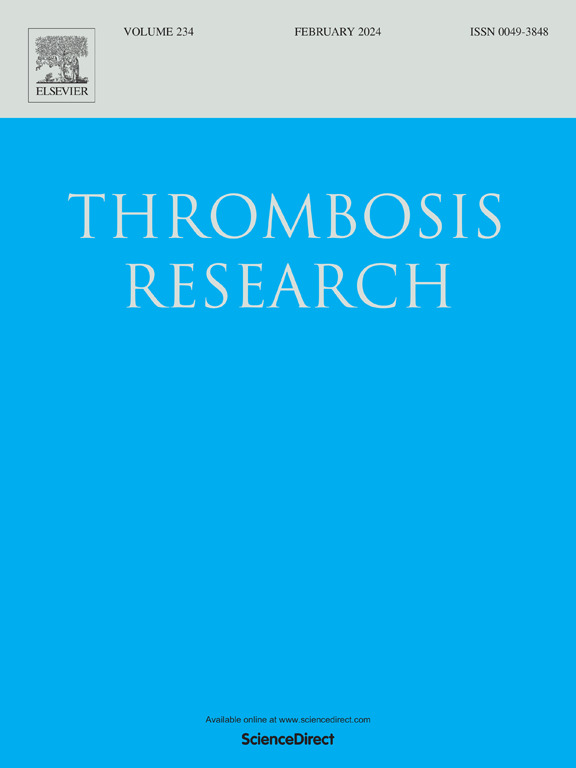Antithrombotic therapy for lower limb peripheral arterial disease: A deep dive into guideline quality and recommendation diversity
IF 3.4
3区 医学
Q1 HEMATOLOGY
引用次数: 0
Abstract
Background
This study systematically evaluates clinical practice guidelines (CPGs) addressing antithrombotic management in lower limb peripheral arterial disease (PAD), aiming to synthesize evidence-based insights for clinical decision-making.
Methods
We systematically identified CPGs published between January 2020 and January 2025 from electronic databases, guideline repositories, and professional association websites. Guideline quality and recommendation validity were assessed using the Appraisal of Guidelines for Research & Evaluation II (AGREE II) and the Appraisal of Guidelines for Research and Evaluation-Recommendation Excellence (AGREE-REX), respectively. Antithrombotic recommendations were extracted and analyzed for consensus and divergence.
Results
11 CPGs met the inclusion criteria. The AGREE II evaluations identified seven high-quality CPGs. The median (interquartile range [IQR]) scores for the AGREE II six domains were as follows: scope and purpose, 88.9 % (16.7 %); stakeholder involvement, 84.7 % (34.7 %); rigour of development, 85.4 % (47.9 %); clarity of presentation, 90.3 % (8.3 %); applicability, 77.1 % (40.6 %); and editorial independence, 85.4 % (33.3 %). For AGREE-REX, the domain scores were clinical applicability, 75.0 % (17.0 %); values and preferences, 29.2 % (15.0 %); and implementability, 41.7 % (15.0 %). A total of 148 key recommendations were extracted. Antiplatelet therapy remains contentious for asymptomatic PAD management. Current guidelines increasingly recommend low-dose rivaroxaban (2.5 mg twice daily) plus aspirin for symptomatic PAD, supported by recent cardiovascular outcome trials.
Conclusion
Current PAD guidelines demonstrate variable methodological quality, necessitating improved rigour of development processes and implementation strategies. Future CPGs should strictly adhere to standardized methodologies and prioritize effective dissemination. Different guidelines present varying opinions on antithrombotic treatment strategies. Recommendations should be periodically revised as new evidence becomes available.
下肢外周动脉疾病的抗血栓治疗:深入探讨指南质量和推荐多样性
本研究系统评估了下肢外周动脉疾病(PAD)抗血栓管理的临床实践指南(CPGs),旨在为临床决策提供基于证据的见解。方法系统地从电子数据库、指南库和专业协会网站上检索2020年1月至2025年1月发表的cpg。采用《研究指南评价》对指南质量和推荐效度进行评价;评估II (AGREE II)和评估卓越研究和评估建议指南(AGREE- rex)。提取抗血栓建议并分析共识和分歧。结果11例CPGs符合纳入标准。AGREE II评估确定了7个高质量cpg。AGREE II六个领域的中位数(四分位数范围[IQR])得分如下:范围和目的,88.9% (16.7%);利益相关者参与,84.7% (34.7%);发展的严谨性,85.4% (47.9%);表述清晰,90.3% (8.3%);适用性,77.1% (40.6%);编辑独立性,85.4%(33.3%)。AGREE-REX的领域得分为临床适用性,75.0% (17.0%);价值观和偏好,29.2% (15.0%);可执行性为41.7%(15.0%)。共摘录了148项重要建议。抗血小板治疗对于无症状PAD的治疗仍然存在争议。目前的指南越来越多地推荐低剂量利伐沙班(2.5 mg,每日两次)加阿司匹林治疗有症状的PAD,最近的心血管结局试验也支持这一建议。结论目前的PAD指南在方法质量上存在差异,需要改进开发过程和实施策略的严谨性。未来的CPGs应严格遵循标准化的方法,优先考虑有效的传播。不同的指南对抗血栓治疗策略提出了不同的意见。当获得新的证据时,建议应定期修订。
本文章由计算机程序翻译,如有差异,请以英文原文为准。
求助全文
约1分钟内获得全文
求助全文
来源期刊

Thrombosis research
医学-外周血管病
CiteScore
14.60
自引率
4.00%
发文量
364
审稿时长
31 days
期刊介绍:
Thrombosis Research is an international journal dedicated to the swift dissemination of new information on thrombosis, hemostasis, and vascular biology, aimed at advancing both science and clinical care. The journal publishes peer-reviewed original research, reviews, editorials, opinions, and critiques, covering both basic and clinical studies. Priority is given to research that promises novel approaches in the diagnosis, therapy, prognosis, and prevention of thrombotic and hemorrhagic diseases.
 求助内容:
求助内容: 应助结果提醒方式:
应助结果提醒方式:


